Sink above the washing machine: the choice and peculiarities of installation
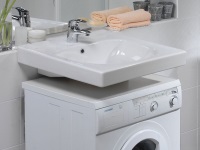
If your bathroom is not big enough, sometimes you have to install a washing machine in it. washing machine have to abandon. A compromise option, combining the sink and washing machine in the same place, can help.
By thinking to install a washing machine under the sink, you can save space, so this option is often of interest to owners of small bathrooms. So you can solve the problem of installing appliances in a room with limited free space.
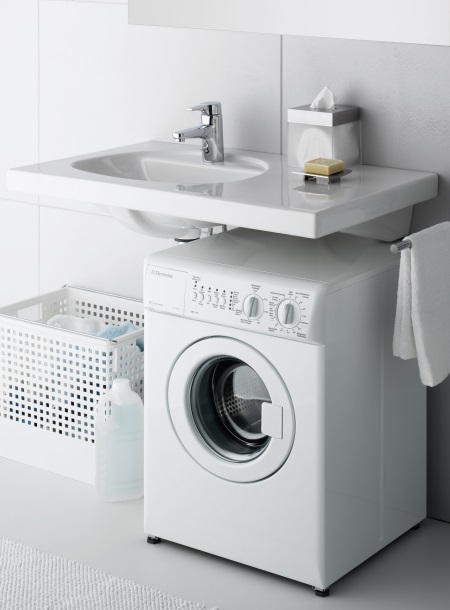
Choosing the place
The problem with the placement of the washing machine is relevant for small apartments, in which the kitchen or bathroom is small. Installing a machine in the bathroom, you can block the passage, in the kitchen to find a place for such equipment is also difficult, if the kitchen dimensions are also small, and the installation in the hallway is not always possible. And a good solution would be to install the machine under the sink - both in the kitchen and bathroom.
So you can really save space and make better use of the area under the sink.
The disadvantage of this arrangement there will be a need to buy a special sink ("lily") and a special siphon. In addition, the likelihood of clogging due to the peculiarities of the drain increases.
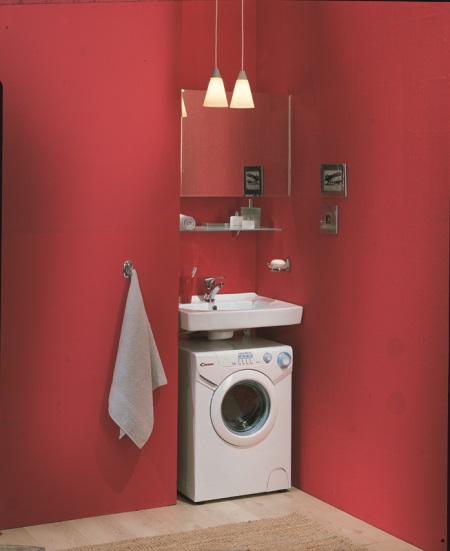
Lily of the water basin
"Lily" is called the model of the sink, which has a very compact pedestal, hidden from sight. Like the flower of the same name over water, such a sink is able to be placed over the surface itself, in this case - over the washing machine.
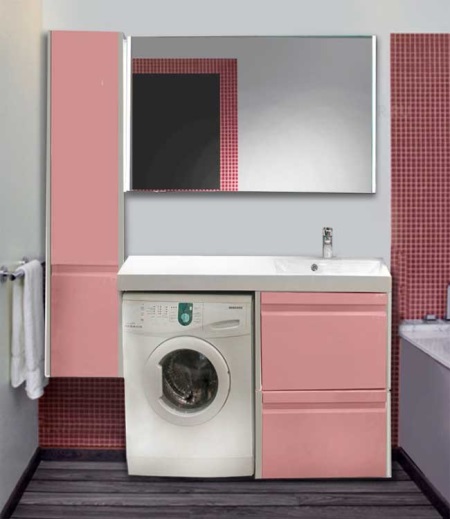
The main feature of the "water lily" sink is its location. Since it is represented by a suspended model, it does not put a load on the appliances below. By choosing this combination, you will increase the usable area of the room, because if you install a conventional sink, the space under it is often not used to the maximum benefit. The "lily" sink can also be used as an additional sink. The advantage of the "lily" is also its diverse appearance, decorating any bathroom.
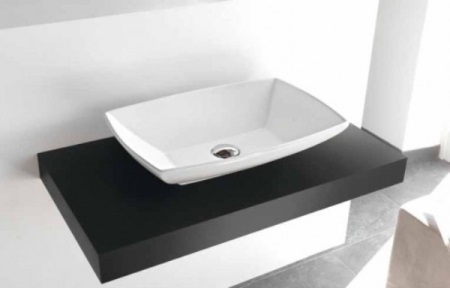
The possibility to buy a "lily pad" of a square shape allows you to perfectly match such a sink with the surface of the washing machine. Although the shape of the sink can also be rectangular, in the form of a semi-circle and non-standard (with angular placement of the mixer or countertop on the side).
The dimensions of the sink are chosen so that they coincide with the dimensions of the machine or were slightly larger, then the appliances will be better protected from splashing.
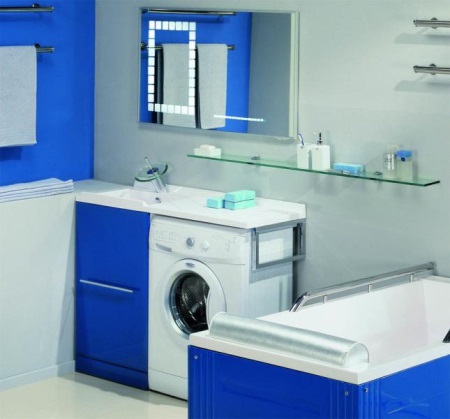
In a "jug" hole for the mixer may be absent, so that the drain can be located as close to the wall as possible. All "lilies" have an overflow, often supplemented by a decorative plug.
When choosing the depth of the "lily of the sea", keep in mind that from a very small sink, there will be more splashing. The drain in such a sink can be located vertically downward or backward (the first option is more convenient to use).
Disadvantages of mounting the sink over the machine
- requires the use of a non-standard siphon. If such a siphon is not included in the set, it may be difficult to buy it (as well as if you need to replace it);
- Due to the drainage of water in some models horizontally, water can be retained in the bowl and the risk of clogging increases. Such sinks need to be cleaned more often;
- If the sink is installed incorrectly, the washing machine will protrude from underneath it and interfere with movement in the bathroom.;
- discomfort is also noted by those who are used to coming close to the sink for hygienic procedures. Although many people agree that it's a matter of habit, and over time it is possible to adapt to the location of the sink over the machine.
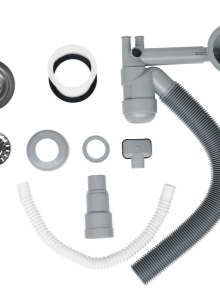
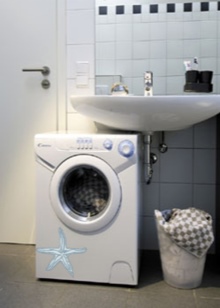
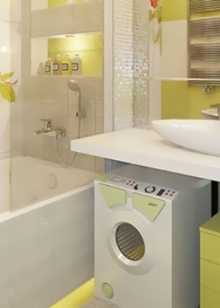
Choosing a jug basin
First, measure the dimensions of the washing machine, and if the drain pipe will be located behind the machine, to the depth of the appliances should be added the distance that the pipe will take. These dimensions are the basis for the selection of the sink. Recall that the product must protrude over the washing machine on all sides. In front it is more convenient to make an overhang of more than 20 cm, then you will be more comfortable to wash. By the way, stores now offer kits in which the "lily" is already matched to the washing machine.

"Lilies" are often made of plastic or ceramic. One of the novelties is the marble "lily" - a sink obtained by vibro-casting from polymer concrete. The finished product has different shades and configurations, so it is easy to match the interior. Such "marble sinks" are lighter than similar wash basins made of marble (artificial, natural), and their price is comparable with the cost of high-quality earthenware products. At the same time, molded marble has indicators of resistance to chemical substances and durability much higher.
Choosing a washing machine
In order to use the "pitcher" was comfortable, the washing machine should have a height of up to 70 centimeters. Then it will be more convenient to wash your hands. In addition to a height of less than 70 cm, such a machine must have minimum depth and width parameters. This is because it is necessary to hide the appliance completely under the sink.
Washing machines, suitable for the room under the sink, are produced by Candy, Eurosoba, Electrolux, Zanussi. Also, one of the narrow models from Samsung can be placed under the sink. Small dimensions do not prevent washing up to 3.5 kg of laundry in such machines, as in many washing machines with standard dimensions.
Experts advise choosing a Candy machine - Candy, because this company produces several suitable models with different spin speeds. Such machines are equipped with many programs for washing and a timer.
Those wishing to get a quality durable unit, you should consider a machine Swiss-made Eurosoba. It attracts a reliable steel drum and body, hand-assembled, high quality components, many modes of operation.
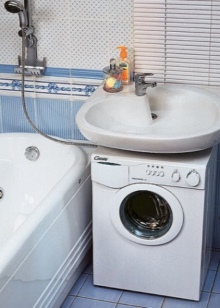

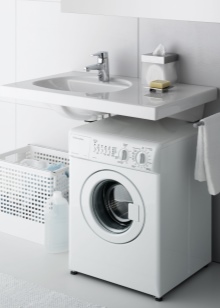
Mounting the basin to the wall
Standard brackets are used to mount the "lily". You can use ready-made brackets that were installed during the construction of the house. They are highly reliable. Mounting brackets usually come with the sink as well. For the attachment of imported sinks uses its own system of fasteners, which is usually included with the model.
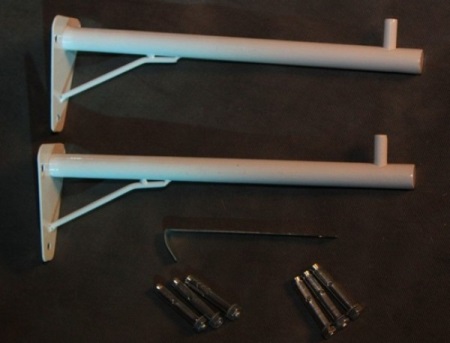
To install, first try on the bowl and mark the fastener locations. Next, drill holes, install the brackets and screws, leaving a gap of about 5 mm. Having aligned the bowl, install the basin on the brackets and insert a metal hook into the hole that is in the back of the basin (it is needed to fix the bowl to the wall).
Use a dowel or self-tapping screw to secure the hook. Next, all the bolts in the brackets need to be screwed completely. From behind, treat the sink with silicone-based sealant.
Installing the sink over the washing machine
Installing the sink over a household appliance, it is important to avoid direct contact between water and electrical wires. That's why the sink is chosen by size slightly longer and wider than the machine. It is desirable to put forward a bowl of at least 5 inches. Drainage nozzles should not be above the washing machine, because due to the vibration of the unit, they can become loose.
Installing the siphon
Installation of the siphon is carried out before the final fixing of the "lily" on the wall. The corrugator is connected directly to the sewer pipe. At this stage, it is important to check for leaks. If leaks are detected, check the gaskets, as well as tighten the connections.
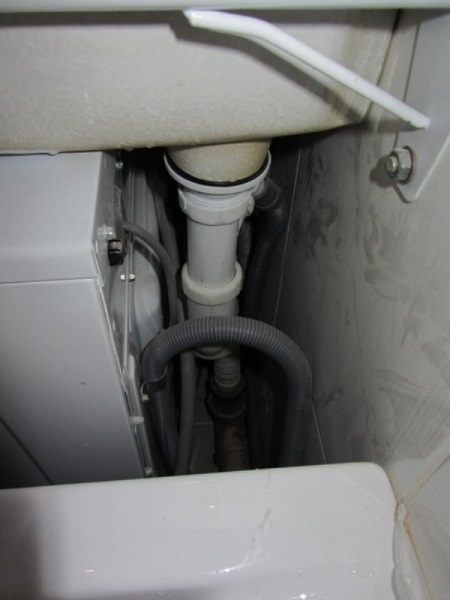
Faucet installation
Most "jugs" have a hole for installing the faucet. When connecting the faucet to the hoses as well as the fittings, use gaskets, and to seal the connections, use fum tape. After a test run, you can note if any connections need to be tightened further.
If the washbasin and bathtub faucet will be shared, make sure that the spout can easily move over the washbasin. In this case, the "jug" is placed so that one side of it hangs over the edge of the bathtub.
Connecting the washing machine
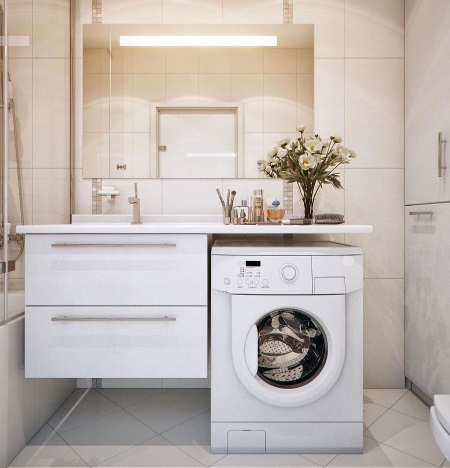
Since when installing the faucet on the "lily" you need to connect the washing machine to the cold water at the same time, you will need a T-piece. It will provide water to both the faucet and the appliance.
Performing installation of the drain from the washing machine, it is important to make sure that the connections are tight. It is recommended to connect the siphon pipe from the sink and the washing machine drain hose. And so that disruption due to high pressure has been excluded, such a connection is strengthened with a clamp.
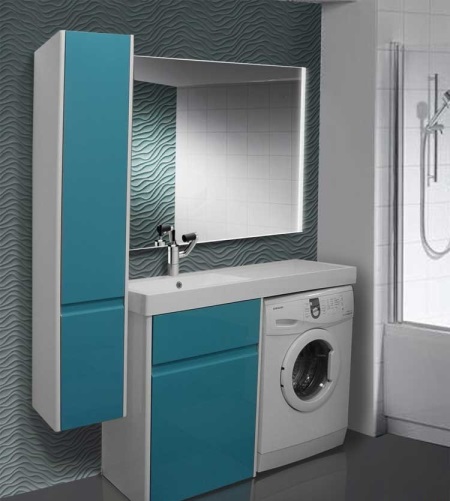
In conclusion, be sure to check again that all units are tight.
After securing the water supply, feel each connection. Even if there is a minimal leak, the machine could malfunction and you could get an electric shock. So, if you don't have the right skills to hook up your machine properly, contact an experienced handyman.





This is a great option for my small bathroom. I can fit a washing machine too)